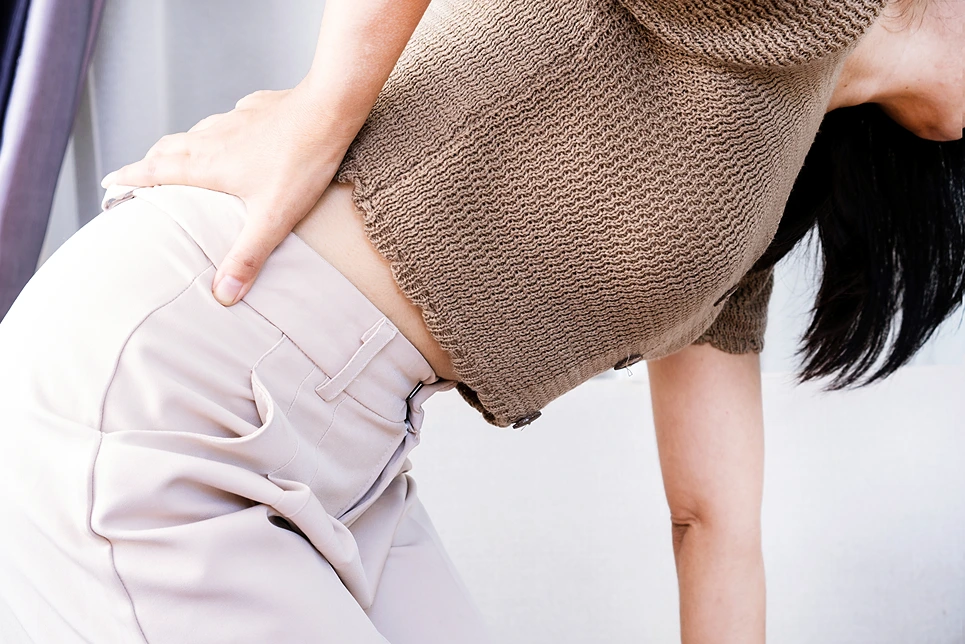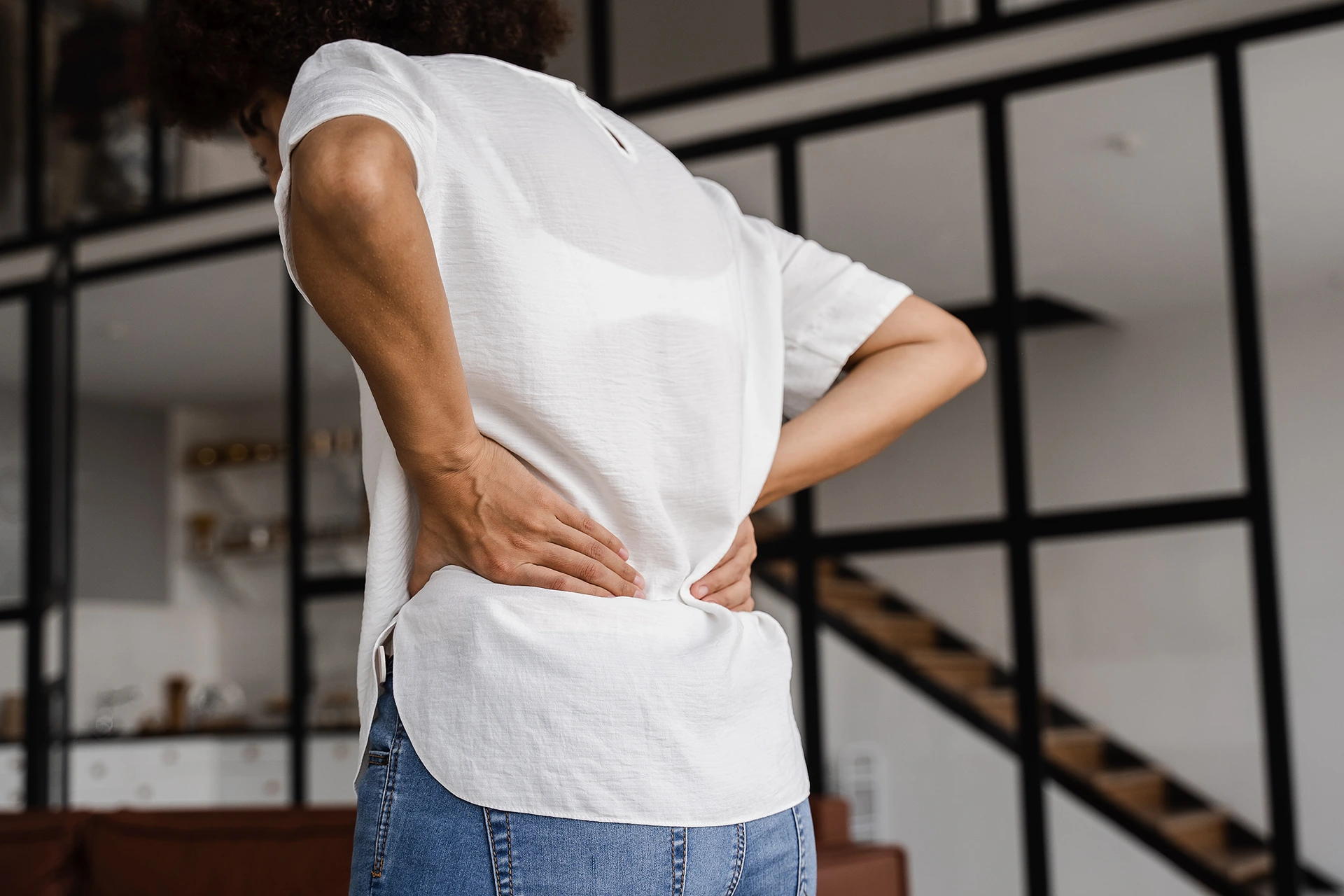Living With Chronic Back Pain? How a Fall Can Lead to Sciatica and What You Can Do About It
If you’re one of the millions of adults suffering from chronic back pain, an unexpected fall can feel like the absolute last thing you need. Maybe you slipped on a wet floor or took a tumble down some stairs. Or perhaps you fell awkwardly after tripping on an uneven sidewalk.
Whatever the cause, it’s only natural to wonder – could this fall make my back pain even worse? More specifically, can an accidental fall bring on symptoms of sciatica if you already have underlying back issues?
At Kaly, we know how scary and disheartening it can be to suffer a fall when you’re already dealing with constant back pain. But we also want to empower you with the knowledge you need to understand how falls might impact sciatica risk.
What Is Sciatica and What Causes It?

Before we dive into the link between falls and sciatica, let’s quickly cover the basics of what sciatica is and what leads to it in the first place.
- Sciatica refers to pain that radiates along the path of the sciatic nerve, which branches from your lower back through your hips and butt and down each leg. It’s often described as a tingling, numbing, or searing pain that starts in the buttocks or back of thigh and travels down the leg.
This neuropathic pain is typically caused by compression or irritation of the sciatic nerve roots in the lower lumbar region of the spine. Several spinal conditions can lead to this nerve impingement and the resulting symptoms of sciatica, including:
- Lumbar herniated disc
- Degenerative disc disease
- Spinal stenosis
- Spondylolisthesis
- Piriformis syndrome
- Isthmic spondylolisthesis
Any of these conditions affecting the lumbar spine can potentially impinge upon the sciatic nerve and cause inflammation, pain, numbness or weakness along the nerve’s path down the leg.
How Could a Fall Be Related to Sciatica?
Now that you understand the common causes of sciatica stemming from spinal issues, you can probably begin to see how an awkward fall could potentially contribute to or aggravate sciatic nerve pain. Here are some of the main ways an accident could play a role:
- Direct forceful impact on the spine – Falling hard onto your back or buttocks delivers a strong forceful jolt to your lower spine. If you fall from high enough, the impact could potentially rupture a lumbar disc or damage the vertebrae, directly compressing or disrupting the sciatic nerve roots.
- Sudden twisting movements – Twisting your back during a fall can wrench the vertebrae out of alignment and strain the ligaments between them. This could potentially pinch or stretch the sciatic nerve. The abrupt twisting motion can also tear or herniate a lumbar disc.
- Muscle, tendon or ligament injury – A fall can cause injuries to the soft tissues around the piriformis muscle and lower spine. Swelling and muscle spasms from strains or sprains in these areas could put pressure on the sciatic nerve, triggering sciatica-like symptoms.
- Exacerbation of preexisting spinal conditions – If you already have spinal issues like spinal stenosis, degenerative disc disease or spondylolisthesis, even a minor trauma from a fall could potentially exacerbate the problem. A little jolt or twisting is all it takes to inflame a lumbar disc or joint and impinge the adjacent sciatic nerve.
Can a Minor Fall Really Lead to Sciatica?

If you’re dealing with chronic back pain, just hearing that a fall can cause sciatica can be disheartening. But could a relatively mild and harmless tumble you barely gave a second thought to really be the culprit behind a sudden onset of radiating sciatica pain?
The answer is – maybe. Here’s what to know:
- The severity of the fall impacts risk. The harder you fall and the more force involved, the higher the chance of direct spinal injury that could affect the sciatic nerve. A light stumble likely poses minimal risk.
- Pre-existing conditions increase vulnerability. If you already have spinal issues like degenerative disc disease or a lumbar herniated disc, even a minor fall could potentially aggravate the problem enough to impinge the sciatic nerve.
- Onset of pain is delayed. You probably won’t experience sciatica pain immediately at the time of a fall. It often takes hours or even days for inflammation around the nerve to build up before symptoms appear.
- Difficult to confirm direct causation. Many variables are at play, and it can be hard for doctors to determine conclusively that a particular fall directly triggered someone’s sciatica. But falls are a known potential cause.
The takeaway here is that even a minor fall can plausibly contribute to or exacerbate sciatica in someone with pre-existing back problems. While severe traumas clearly raise the risk, don’t downplay a small tumble as completely harmless either.
Does the Location of Fall Impact Sciatica Risk?
Not all falls are created equal when it comes to the possibility of developing sciatic pain afterwards. The location on your body that takes the impact can play a role in whether the fall could negatively affect your lower back and sciatic nerve.
| Location | Impact on Sciatica |
| Landing on buttocks | Falling directly onto your backside puts the impact force right on your tailbone and lower spine, where the sciatic nerve roots begin. This increases the likelihood of injuring a disc or vertebrae in a way that impinges the nerve. |
| Twisting ankle or knee | An awkward fall that twists or jolts your knee or ankle can transfer reverberating forces all the way up your leg to your lower back. This indirect jarring effect on the lumbar spine may irritate the sciatic nerve. |
| Landing on knees | A fall directly onto your knees can transmit a great amount of force up through the legs to the hips and lower spine. This could potentially contribute to sciatica symptoms. |
| Striking elbows or shoulders | Falling forward onto your elbows or shoulders drives impact forces through your upper body. While this does not directly affect the lumbar spine, it can still jolt the entire body, including the lower back. |
| Hitting side of body | A sideways fall may avoid direct trauma to the spine, but still involves a twisting motion. This torques the back awkwardly and can strain soft tissues surrounding the sciatic nerve. |
As you can see, just about any type of fall where significant force transfers through or near the lower back carries some risk of irritating the sciatic nerve and contributing to sciatica pain. But direct trauma to the base of the spine appears most likely to cause problems.
Preventing Sciatica and Falls in the Future
Once you’ve begun recovering from a sciatica flare up caused by a fall, it’s only natural to start thinking about prevention. Here are some tips:
- Exercise regularly to build core and leg strength. Strong muscles help stabilize your back and make you less prone to falls.
- Practice balancing exercises to improve stability and coordination. This also reduces fall risk.
- Consider physical therapy to address muscle imbalances or gait issues. A PT can provide customized exercises targeting these.
- Watch your step when walking on uneven or slippery surfaces. Take your time and be cautious.
- Wear supportive footwear with good traction. This helps avoid slips that could lead to falls.
- Use mobility aids if needed. Canes, walkers, or grab bars provide stability if you have any instability or dizziness.
- Address tripping hazards at home. Remove loose rugs, clutter, and cords that could cause an accidental fall.
- Improve home lighting. Ensure you have good lighting, night lights, and light switches accessible to avoid falls in dim conditions.
- Manage chronic conditions proactively. Having other issues like diabetes or poor vision under control helps minimize fall risk.
- Ask your doctor about supplements. Some supplements like vitamin D may improve muscle strength, stability, and bone health to avoid falls.
Being proactive about both spinal health and fall prevention is your best defense against dealing with post-fall sciatica pain again in the future.
The Takeaway

While falls can unfortunately contribute to or aggravate sciatica, particularly if you already have underlying spinal issues, do know that there are many effective options for finding relief. Don’t hesitate to seek help.
Here at Kaly, we truly understand how difficult and discouraging managing chronic back pain can be – and a fall-induced flare up only adds to the struggle.
But we want you to know that you don’t have to handle this in isolation. We are your partner through it all, ready to provide expert information, advice, and most importantly, a compassionate community who gets it.
